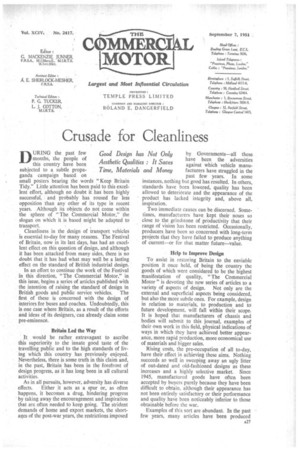Crusade for Cleanliness
Page 29

Page 30

If you've noticed an error in this article please click here to report it so we can fix it.
DURING the past few months, the people of this country have been subjected to a subtle propaganda campaign based on small posters bearing the words "Keep Britain Tidy," Little attention has been paid to this excellent effort, although no doubt it has been highly successful, and probably has roused far less opposition than any other of its type in recent years. Although its objects do not come within the sphere of "The Commercial Motor," the slogan on which it is based might be adapted to transport. Cleanliness in the design of transport vehicles is essential to-day for many reasons. The Festival of Britain, now in its last days, has had an excellent effect on this question of design, and although it has been attacked from many sides, there is no doubt that it has had what may well be a lasting effect on the standard of British industrial design.
In an effort to continue the work of the Festival in this direction, "The Commercial Motor," in this issue, begins a series of articles published with the intention of raising the standard of design in British goods and public service vehicles. The first of these is concerned with the design of interiors for buses and coaches. Undoubtedly, this is one case where Britain, as a result of the efforts and ideas of its designers, can already claim some pre-eminence.
Britain Led the Way It would be rather extravagant to ascribe this superiority to the innate good taste of the travelling public and to the high standards of living which this country has previously enjoyed. Nevertheless, there is some truth in this claim and, in the past, Britain has been in the forefront of design progress, as it has long been in all cultural activities.
As in all pursuits, however, adversity has diverse effects. Either it acts as a spur or, as often happens, it becomes a drug, hindering progress • by taking away the encouragement and inspiration that are often needed to keep going. The strident demands of home and export markets, the shortages of the post-war years, the restrictions imposed by Governments—all these have been the adversities against which vehicle manufacturers have struggled in the past few years. In some instances, nothing but good has resulted. In others, standards have been lowered, quality has been allowed to deteriorate and the appearance of the product has lacked integrity and, above all, inspiration.
Two immediate causes can be discerned. Sometimes, manufacturers have kept their noses so close to the grindstone of productivity that their range of vision has been restricted. Occasionally, producers have been so concerned with long-term projects that they have failed to produce anything of current—or for that matter future—value.
Help to Improve Design To assist in restoring Britain to the enviable position it once held, of being the country the goods of which were considered to be the highest manifestation of quality, "The Commercial Motor" is devoting the new series of articles to a variety of aspects of design. Not only are the external and superficial aspects being considered, but also the more subtle ones. For example, design in relation to materials, to production and to future development, will fall within their scope. It is hoped that manufacturers of chassis and bodies will submit to this journal, examples of their own work in this field, physical indications of ways in which they have achieved better appearance, more rapid production, more economical use of materials and bigger sales.
Rising costs, the pre-occupation of all to-day, have their effect in achieving these aims. Nothing succeeds so well in sweeping away an ugly litter of out-dated and old-fashioned designs as these increases and a highly selective market. Since 1945, manufactured goods have often been accepted by buyers purely because they have been difficult to obtain, although their appearance has not been entirely satisfactory or their performance and quality have been noticeably inferior to those obtainable before the war.
Examples of this sort are abundant. In the past few years, many articles have been produced A27 which have been tricked out with fanciful decorative effects in an attempt to make them look newer than they really are. Again, what are described as new models often turn out, on closer inspection, to be old ones thinly disguised with far from satisfactory ornamentation, which usually is not at all consistent with the original, quite sound design.
This has been true even in critical export markets. It is noteworthy, however, that corn petitors, such as Germany, have made a deep impression in fields where Britain has, hitherto, reigned supreme, purely because the products offered have been created to meet present-day conditions. Britain need not fear this, but efforts should be made to raise the standard of design still further, by eradicating costly and unnecessary frills, so as to make British products the standard by which all others are judged, and from which all other design will develop.
























































































